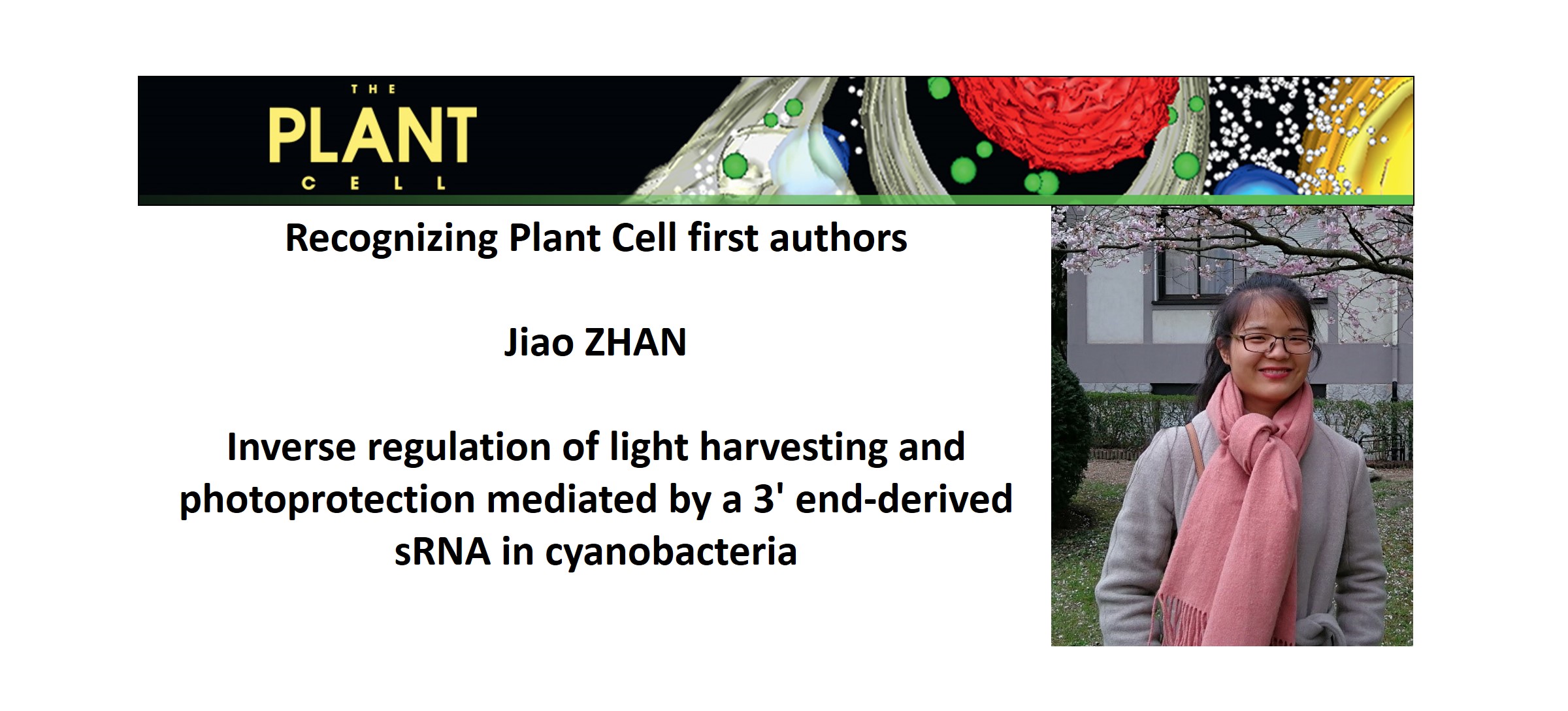Recognizing Plant Cell authors: Jiao Zhan
Jiao Zhan, first author of Inverse regulation of light harvesting and photoprotection mediated by a 3′ end-derived sRNA in cyanobacteria
Current Position: Assistant researcher, Institute of Hydrobiology, Chinese Academy of Sciences
Education: Ph.D., Genetics, University of Chinese Academy of Sciences, China; B.S. Living marine resources and Environmental Science, Ningbo University, China
Non-scientific Interests: running, travelling, classic music and hiking
Brief bio: I have always been interested in how cyanobacteria respond and adapt to changing environment. In 2016, I obtained the PhD’s degree in Genetics at Institute of Hydrobiology, Chinese Academy of Sciences, China. In 2017, I moved as a postdoc to Diana Kirilovsky’s lab in Paris. One of my research topics there was to find out the reason why a mutant lacking the phycobilsome (PBS) core linker protein (ApcC) displayed an unexpected phenotype of a high level of water soluble orange carotenoid protein (OCP) expression. OCP is the key protein of none photosynthetic quenching mechanism (NPQ) in cyanobacteria. In this paper, we clearly show that the increase of OCP concentration in ΔapcC was related to the absence of a small regulatory RNA (sRNA) that we called ApcZ. ApcZ originates from the 3’ end of the tetracistronic apcABC-apcZ operon, an operon encoding the allophycocyanin subunits of the phycobilisome. ApcZ homologs exist in OCP-containing cyanobacterial strains with different morphologies and lifestyles. ApcZ inhibits ocp translation under non-stress conditions. Under most stress conditions, apc operon transcription decreases and ocp translation increases. The direct interaction of ApcZ with the ocp/slr1963 mRNA was confirmed using an heterologous reporter system. These suggest a crosstalk between Light Harvesting and Photoprotection mediated by 3’ end derived sRNA ApcZ.
湛交:Inverse regulation of light harvesting and photoprotection mediated by a 3’ end-derived sRNA in cyanobacteria
目前的职位:助理研究员,中国科学院水生生物研究所
教育背景:博士,遗传学,中国科学院大学;学士,海洋生物资源与环境专业,宁波大学。
兴趣爱好:跑步,旅游,徒步以及古典音乐
简介:我长期关注蓝藻及真核藻类对环境条件变化的响应及其分子调控机制。我于2016年从中国科学院水生生物研究所毕业,获得遗传学博士学位。同年我留所担任助理研究员,并于2017年来到法国原子能委员会Diana Kirilovsky实验室进行博士后研究。期间,探究集胞藻PCC6803的ApcC缺失突变株(ΔapcC)为何呈现出相对野生型更高的可溶性橙色胡萝卜素蛋白(OCP)的表达及光保护。OCP是蓝藻中藻胆体吸收光能的非光化学淬灭机制(NPQ)的核心,OCP与藻胆体(PBS)的比例越高,光能淬灭效率越高。我们发现该表型是由于该突变体中ApcC蛋白的插入失活导致位于藻胆体编码基因操纵子apcABC 操纵子3‘末端的一个sRNA无法正常转录导致的。 我们将该sRNA命名为ApcZ,该sRNA具有自己独立的启动子。正常条件下,ApcZ和操纵子apcABC-apcZ的表达量相对较高,进而抑制ocp mRNA的翻译,获得相对较低的OCP/PBS,从而确保光能较少的转化为热,最大效率进行光合作用;而大部分胁迫条件下,自由ApcZ及apcABC-apcZ表达量都下调,OCP的表达水平提高,藻胆体含量下调,获得相对较高的OCP/PBS比例,最终提高光能淬灭效率。而在缺氮胁迫条件下,当藻胆体基因apcABC表达显著下调时,ApcZ仍具有相对高的表达水平,实现对OCP的表达调控。我们通过大肠杆菌报告系统证实了ApcZ与slr1963/ocp 起始密码子附近区域的互补配对是ApcZ对OCP蛋白表达进行负调控的基础。这些结果表明,通过3’ 末端 sRNA ApcZ参与调节,蓝藻的光能吸收和光保护实现了对话。




